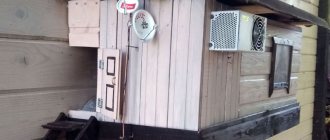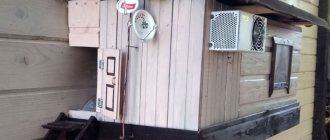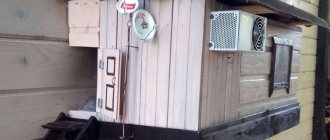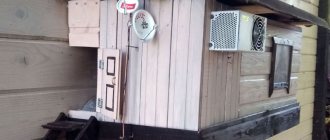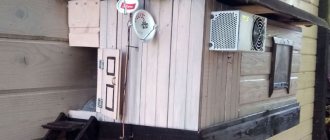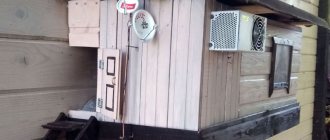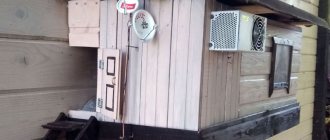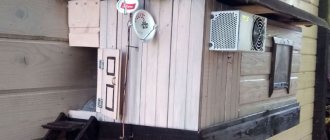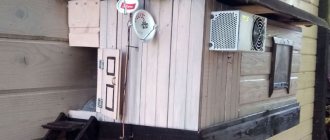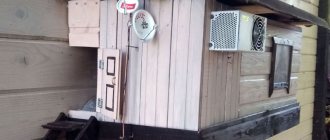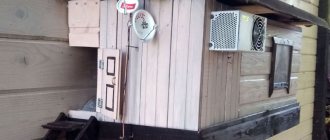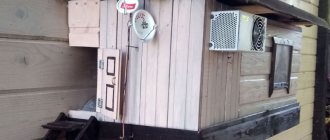Another homemade product for those who are bored at home
I needed a couple of antennas for digital, in places with “not the best reception”... I went shopping (this was before self-isolation - if it’s relatively budget-friendly, then it’s complete G. The more expensive one looks decent, but how it works is questionable.
- if it’s relatively budget-friendly, then it’s complete G. The more expensive one looks decent, but how it works is questionable.
I decided to make something homemade. It was somehow awkward to “twist” an antenna from a piece of cable (although rumor has it it works) - I wanted something simple, but more decent and advanced
In fact, the one I made is not radically more complicated, but somehow more “solid” or something. And the results of its testing were very encouraging, so I decided to sketch out a short description of what and how, in case someone else finds it useful 
... even if my street cats have a “normal” antenna on their house, what can you do without an antenna?!
The wire is not all finished yet, now we’ll assemble something!
In the places described, I previously used home-made broadband log-periodic antennas, probably since the “beginning of perestroika.” They worked well in analog and not only on UHF, but “for some reason, digital was too tough for them.” I didn’t really delve into the essence of the reasons, I removed them and began to think about what to replace them with. Here is one of them, waiting for a place in the trash
They worked well in analog and not only on UHF, but “for some reason, digital was too tough for them.” I didn’t really delve into the essence of the reasons, I removed them and began to think about what to replace them with. Here is one of them, waiting for a place in the trash
A little history
In the early 60s of the last century, our compatriot Kharchenko K.P. developed a simple flat zigzag antenna with good characteristics.
Copyright certificate No. 138277 for an invention called “Band directional antenna” was issued to Konstantin Pavlovich Kharchenko in 1961 (according to his application dated June 16, 1960). In the same year, materials were published in the magazine “Radio” for repetition by radio amateurs.
The antenna is not critical to materials and dimensions during manufacturing, has a simple good match with the reduction cable, and it successfully combines multiple elements of a common-mode antenna array with a single feed point.
Aluminum disc
For production we will need:
- aluminum disk 1 mm thick;
- printed circuit board made of fiberglass 1 mm thick;
- matching transformer;
- cable with characteristic impedance 75 Ohm.
In an aluminum disk with a diameter of 356 mm, with a hole in the middle with a diameter of 170 mm, a 10 mm cut is made. Instead of a sawn piece, a printed circuit board is installed, to which a matching transformer is soldered. Instead, you can install an amplification device taken from the kit that comes with the Polish antenna.
Theory and calculations
The described antenna, in theory, has a horizontal “figure-of-eight” radiation pattern and a relatively high gain, which can be further increased by using a reflector/reflector.
To obtain maximum gain on all channels, it is necessary to make an antenna approximately in the middle of the range between the multiplexes used.
Finding (for calculations) the frequencies of multiplexes used in your region is easy,
for example, a request like “dvb-t2 channel frequencies” + “Krasnodar”
I found something like this:
The middle, between “my” two multiplexes, is 700 MHz - we will calculate the antenna at this frequency.
As a basis for calculating the dimensions of the antenna, we take the drawing of its author
Calculate the wavelength: λ = 300 / f [m]
300/700 = 0.428m, approximately 43cm length of each side of the rhombus
λ/4
=43/4= 10.75
The total length of the material we need (11cm*8=88cm) is less than a meter. The distance between the reduction contacts, where we will solder the cable, is 10-12mm (the standard value for this antenna for frequencies below 900 MHz).
I will make a simple antenna, without a reflector, however, to further increase the gain of this antenna, it is quite possible to install it behind it
for example, from a metal mesh/grill, foil material or simply a metal plate. Its dimensions should be approximately 20 percent larger than the dimensions of the antenna and it should be located at a distance of ƛmax/7. For my case: wavelength (channel 39) 300/618, it turns out...49/7= that is, about 7cm
For those who are too lazy to do the calculations themselves
— you can use an online calculator, the results will differ only slightly from those I received. Here, for example, this one - here you immediately enter the frequencies of two multiplexes and get the dimensions of the antenna (without a reflector) Or another option, with a reflector - I really want to note that in the second option a slightly different calculation option is used, different from the author’s. An antenna with angles other than 90° is assumed and the reflector distance is calculated as λ/8
To make the antenna sheet, it is recommended to use aluminum or copper (copper is easily soldered) with a diameter of 3 mm and higher - the larger the diameter, the more broadband the antenna is. You can use tubes; the thickness of the walls is not important, since only the surface of the material is used (in fact, you can wrap any dielectric with foil to obtain the required material). However, in my opinion, the easiest way is to buy a meter of large-gauge copper wire at an electrical supply store.
Advantages of the UHF range
The length of decimeter waves is 10 cm – 1 m, depending on the selected frequency.
Unlike meter waves, decimeter waves have a smaller area of propagation - within visibility. Shorter waves reflect better from obstacles in the path. Therefore, it is more rational to use them among multi-story buildings or industrial buildings - when reflected from their surfaces, they will cover more receivers.
Despite the fact that UHF is inferior to HF in wave propagation range, it is ahead of other popular frequency ranges, such as 2G/GSM, 3G/UTMS and 4G/LTE. One television transmitter in the range of 300-900 MHz is enough to cover large cities and small towns surrounding them.
Another advantage of UHF is noise immunity. Moreover, the narrower the operating frequency range, the less likely it is to jam the signal or overload the receiving antenna. Together with digital technology DVB-T2, decimeter waves convey to users only a good picture with sound.
With analog TV, we are accustomed to noise on the TV screen when the signal is poor. Due to the peculiarities of DVB-T2 technology - when receiving a digital signal, the quality is either excellent or there is no reception at all.
Antenna assembly
Let's remove the insulation from a piece of wire one meter long.
I got a wire with a diameter of 4.5mm
The tools you will need are a vice and a hammer. Measure approximately 11cm each and bend at an angle of 90°
The end result is to get such a “geometric” figure 
We cut off the excess and solder the ends. It should look something like this...
Solder the cable as shown in the photo.
We lay the cable along one side of the square and secure it with clamps. This arrangement of the cable is necessary for its coordination (there are different opinions, not everyone agrees with this statement).
When using a reflector, the antenna sheet at the extreme points of the squares can also be secured using metal stands, for example, soldered onto the remains of the same copper wire - there are points with zero potential (highlighted in green). In other places, fastening is allowed only through a dielectric.
Bottom line: which option to choose?
Oddly enough, the simplest option is the most effective, so the “loop” is best suited for receiving a “digit” (Fig. 4). But, if you need to receive other channels in the UHF range, then it is better to stop at “Zigzag” (Fig. 6).
Recommendations.
The antenna for the TV should be directed towards the nearest active repeater, in order to select the desired position, you should rotate the structure until the signal strength is satisfactory.
If, despite the presence of an amplifier and reflector, the quality of the “picture” leaves much to be desired, you can try installing the structure on a mast.
Do-it-yourself decimeter antenna mounted on a mast
In this case, it is necessary to install lightning protection, but this is a topic for another article.
Tests
And finally, a performance check and a rough
assessment of the quality of the resulting antenna.
In fact, everything is simple with the test - turn it on, it works! And to evaluate whether the game was “worth the candle,” let’s compare the parameters of the received signal from the manufactured antenna with the one I’m already using at the dacha, with a declared gain of 11dBi
And to evaluate whether the game was “worth the candle,” let’s compare the parameters of the received signal from the manufactured antenna with the one I’m already using at the dacha, with a declared gain of 11dBi
The antenna is installed in the attic of a country house, at a distance of approximately 16 km from the tower.
Signal level: factory stationary antenna on the left / homemade on the right
At first glance, the difference is only 1% (95 versus 94) - but this is not a completely correct comparison, since my external antenna is connected through a splitter, which further weakens the signal.
What you can do with your own hands
Below is a list and brief description of antennas for digital television.
- A television antenna made from a piece of coaxial cable. Externally, this is an ordinary loop that can be installed both outside and inside the building. It is recommended to make it yourself if the repeater is located no further than 15 km.
- Antenna made from beer cans. The characteristics are very similar to a loop, but can be done in conjunction with an amplifier. This allows you to catch a signal from towers that are up to 40 km away.
- Butterfly. The name directly matches the appearance. Reminds me of butterfly wings. More powerful than the previous two options. Without an amplifier it catches for about 20 km, and with it the reception range increases to 70 km.
- Triple square (Sotnikova). A more complex device in terms of manufacturing. The operating range with an amplifier is about 60 km, and without it it is equal to the simplest designs (loop and can) - about 15 km without interference.
- Kharchenko (bisquare, double square, figure eight, zigzag, zigzag, diamond, double diamond). It is recommended to be used in conjunction with an amplifier, thanks to which it is possible to configure channels from a tower located up to 50 km.
- Log-periodic. The most complex version of an antenna for digital TV with your own hands. The receiving elements are made of different lengths. It is necessary to accurately calculate the length of each vibrator. But reception up to 100 km is possible.
Each device can be placed in a room. Especially the design made from cables or cans. They are not so bulky, so you can easily fix the structures near the window of the room or on the balcony.
The log-periodic antenna is designed for reception over long distances, so it is better to install it outdoors. In addition, it is inconvenient to place the device indoors; it has a long axis.
Even a person without experience can make the first 4 antennas with their own hands. The main thing is to have the necessary materials on hand and perform simple (or not so simple) calculations.
There are also much more complex designs of DVB-T2 receivers. They require complex calculations, but are not much better than the options described above. Therefore, there is no point in making such antennas. Some options:
- Turkin device;
- Kovacheva;
- Wave channel.
Assessing the performance of the antenna
Let's try to make a more correct comparison by connecting through the splitter input.
Well, in addition, for clarity, let’s add the number of participants List of antennas taking part in the comparison:
1. External antenna Funke BM 4551 external long-range,
declared gain, from some sources (bought at Yulmart), up to 16dB
2. There is an old UHF loop antenna, from TV Electronica 313d, I must say, despite its simplicity, it’s a very good antenna, that’s why it’s been preserved 
3. I went to the store and bought for comparison in the review one of the cheapest, such as a symmetrical vibrator (100% the most purchased by pensioners, due to the low price).
I will carry out all “measurements” at one point, located as close as possible to the external antenna - its location was experimentally selected based on the maximum signal, so we can say that the conditions are approximately the same
So, we have already seen the signal level from the external antenna at 95% (at the time of current measurements it showed 94%), we take it as a standard. All comparisons are made by connecting antennas to the input on the splitter, to which an external antenna is usually connected.
Loop antenna, from Electronics 82% on 39 multiplex and 66% on 60
Budget with “horns” - 62%/38% (on the verge of losing the broadcast)
- 62%/38% (on the verge of losing the broadcast)
Double square - 92% on both multiplexes, about a couple of percent less than the external one
Out of curiosity, I decided to check the work of the reflector, which is easy to make from any metal mesh, plate or even foil... It REALLY works noticeably! The level rose to 96%!, which is even higher than the stationary one, with a declared gain of 11dB.
The most interesting thing is the object that I used as a reflector! 
There was no foil in the house; the only thing available with a metal surface of the required size was... a laptop cover (I have a metal case). But the main thing is the result! It’s clear that I’m not going to “tie” the laptop to the antenna, and its amplification is enough for me without a reflector
About satellite reception
There is no point in making a satellite dish yourself. You still need to buy a head and a tuner, and behind the external simplicity of the mirror lies a parabolic surface of oblique incidence, which not every industrial enterprise can produce with the required accuracy. The only thing that DIYers can do is set up a satellite dish; read about that here.
Conclusion:
I can confidently recommend repeating it!
Simple, “cheap and tasty”... One of the simplest, indoor antenna mounts... with ordinary suction cups - if you’re lucky with the direction to the television center
The next antenna "recommended for repetition" is... log periodic
“Crazy hands” were with you. Good luck and good mood to everyone! ☕
Good luck and good mood to everyone! ☕
Wave channel
A simple design, highly efficient directional antenna that can be used in almost the entire television broadcast range. The antenna is an active half-wave vibrator (usually a loop), a reflector of several directors mounted on the base of the boom, fixed with staples or welding. The vibrator with the boom is fixed to the mast. The connection of the cable and the balancing-matching U-shaped elbow to the active vibrator is made using a special box.
A half-wave elbow is made from sections of coaxial cable with a length equal to the average wavelength divided by two. The U-elbow is both a balun and a resistance transformer: it changes the input resistance of the loop vibrator from 292 Ohms to 73 Ohms, which makes it possible to ensure matching of the vibrator with the feeder. The braids of the elbow cable must be soldered together, as well as with the braid of the feeder. The length of the piece of wire used will be approximately 185 mm.
Canning
This original antenna, which is easy to make yourself, is not inferior in parameters to a log-periodic antenna. It is assembled from two tin cans. Cans are taken with dimensions of 75x95 mm. Using two strips of fiberglass, the cans are connected by soldering. One strip is solid, and on the second there is a gap into which the cable is soldered. Its operating principle is based on the property of a symmetrical broadband vibrator, due to which it has a high gain.
The types of antennas considered can be easily connected to all kinds of set-top boxes for receiving digital television and even FM.
Amplifier
To improve television reception, an antenna with an active signal amplifier is often used. Typically, such an amplifier does not need tuning and is made using low-noise transistors with a gain of about 20 dB.
In order to make a TV signal amplifier with your own hands, you will need a printed circuit board and the following list of radio elements:
- Resistors: R1, R5—220 Ohm; R2, R6—8.2 kOhm; R3—3.3 kOhm; R4, R8—22 Ohm; R7— 1.5 kOhm.
- Capacitors: C1—0.01 µF; C2, C4, C6—220 pF; C3, C5—100 nF.
- Transistors: VT1, VT2 S790T.
The antenna amplifier circuit for a TV with your own hands will look like this:
https://masterkit.ru/images/magazines/3_SH3 04 .gif
The amplifier is made using S790T transistors according to a common emitter circuit and has two correction chains R1, C3 and R5, C5. The device is assembled on two amplification stages. The central core of the input cable is soldered to the input of capacitor C2, and the screen braid is soldered to the common ground. The amplified signal is removed from the output of capacitor C6.
The amplifier for the antenna is soldered on a separate independent board, and the radio elements on it are mounted using a hinged method. The board is mounted in the middle of the antenna, this arrangement allows you to effectively receive the signal.
How to choose an antenna for Digital TV at the dacha. Types of country antennas
Satellite
They have a large body with a metal disk that effectively reflects the waves and redirects them to the irradiator with a convector. The signal then goes to the tuner and to the TV.
The difference between such antennas is that they receive the signal directly from the satellite, where the trajectory excludes the passage of forests, buildings, mountains and other obstacles. This is especially practical in buildings remote from civilization and in highly uneven terrain.
Advantages:
- high image quality;
- good sound;
- wide variety of channels;
- the opportunity to use foreign programs for language learning;
- viewing the broadcast schedule directly on the screen.
Flaws:
- the cost is higher;
- more expensive maintenance in case of breakdown;
- The signal quality deteriorates in heavy snowfall.
Essential
Simple models that work with a signal from a TV tower or repeater. They are divided into analog and digital, where there is a different range of sensitivity and, as a result, differences in image quality.
Suitable for periodic or permanent use in a country house not too far from the city (up to 30-80 km).
Advantages:
- less weight;
- simple installation;
- cheap;
- There are models with an amplifier;
- frequency variety;
- capable of picking up digital signals;
- there are collective models.
Flaws:
- amplifiers in the housing often break;
- the device may be damaged by the wind;
- signal quality is greatly influenced by weather conditions;
- To catch different channels you have to change the direction of the device.
Polish
If you don’t have the opportunity or desire to make an amplifier yourself, you can purchase a ready-made one. Particularly popular are those found in so-called Polish antennas, for example, from Sowar. The Polish antenna operates in the broadband range, i.e. it can receive UHF and meter signals. However, in the form in which it exists, it is not very suitable for receiving DVB-T digital television, so modifications are recommended for its use.
The thing is that the input impedance of the amplifier is higher than the impedance of the antenna. To begin with, we remove the long meter-long active vibrators or shorten them to decimeter sizes, then remove the reflector sheet from the active vibrators. Thus, the antenna resistance changes. It is advisable to remove the matching unit, a ferrite ring, from the amplifier. This will help expand the range, increase the resistance, and change the frequency response.
Zigzag device
An easy-to-manufacture wide-range antenna. Operates in double frequency band. The design consists of two vertical slats mounted on a dielectric stand. Steel strips are attached to the upper and lower ends of the rack. Planks of the same type, but through insulating washers, are fixed to the ends of the slats. On the stand between the slats there is a non-conductive plate on which two conductor plates .
A cable with a diameter of 3-4 mm is connected to steel strips. It is also soldered to the bottom bar. The wire is laid parallel to the side of the inner cable of the lower frame and soldered to the strips (braided on the left, center conductor on the right).
To simplify the design, you can use only one diamond, a zigzag. The size of such a rhombus will be 340x340 mm. The distance between two metal strips in the center of the diamond is about 10 mm. The material used is aluminum, copper or brass tubes, or strips 6-10 mm wide.
Calculation
UHF antenna vibrators are made of tubes with a diameter of 14 to 25 mm, the supporting boom is 18-35 mm. The mast can be made of tubes with a diameter of 40-50 mm, with a wall of 3-4 mm, or a wooden beam 60x60 mm.
It is recommended to use a three-element antenna, 50-70 five or seven-element, 70-80 eleven-element at distances of 40-50 km from the TV tower.
The distance between the elements of the device can be calculated in programs specially created for this: Antwu 15, 4K6D, etc. These utilities are Russified , it will not be difficult to figure it out.
